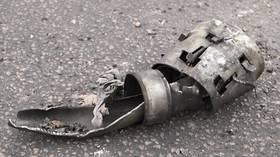Expectation v reality: Watch Falcon SpaceX rocket fall & explode attempting barge landing (VIDEO)

The private spaceflight company SpaceX has launched a reusable rocket that is supposed to deliver a NASA ocean-monitoring satellite into low-Earth orbit. However, the audacious plan to land the rocket on a platform at sea in the Pacific Ocean did not go as smoothly as planned.
SpaceX failed to land the Falcon 9 rocket on the platform, despite the first stages of the launch being successful, the company officials said. The touch-down must have been “hard,” since the rocket’s landing leg broke.
And we have liftoff of the #Jason3 satellite to monitor sea level rise. Watch: https://t.co/KX5g7zfYQehttps://t.co/zCNvwbN3rA
— NASA (@NASA) January 17, 2016Commenting on the failed effort, SpaceX’s CEO, Elon Musk, compared a rocket landing on a floating platform to a jet landing on an aircraft carrier, saying that it’s more difficult than landing on the ground. “However, that was not what prevented it being good. Touchdown speed was ok, but a leg lockout didn’t latch, so it tipped over after landing,” he explained on his Twitter page.
The Space X Flacon 9 rocket took off with the Jason-3 satellite from California's Vandenberg Air Force Base at 10:42 a.m. PST (1842 GMT), as planned.
Jason-3 will continue the research started in 1992 by measuring the topography of the ocean floor which could help forecast weather patterns, predict hurricane intensity and basically monitor Earth’s climate.
First stage separation is confirmed! Watch: https://t.co/L5Lav544lipic.twitter.com/OPb5xHNQeT
— NOAA Satellites (@NOAASatellites) January 17, 2016“More than 90 percent of all the heat being trapped in the Earth's system ... is actually going into the ocean,” Laury Miller, Jason-3 lead scientist, said ahead of the launch. “This makes the ocean perhaps the biggest player in the climate change story.”
It took an hour to deploy the satellite before it finally reached low-Earth orbit. A separate part of the rocket, which was supposed to return to Earth, successfully detached three minutes after the launch.
First stage on target at droneship but looks like hard landing; broke landing leg. Primary mission remains nominal → https://t.co/tdni53IviI
— SpaceX (@SpaceX) January 17, 2016It tried to touch down on a platform floating in Pacific Ocean jokingly named “Just Read the Instructions,” located 186 miles (300 km) south of the launching pad.
Out at sea for tomorrow's launch and landing attempt pic.twitter.com/9LMsj6qryI
— SpaceX (@SpaceX) January 17, 2016The idea to land the rocket on a platform in the ocean is based on a future perspective to reuse rockets carrying out more demanding tasks when there’s not enough fuel left to reach land. Apart from that, SpaceX hasn’t received an environmental approval for ground landings and it had to move the landing site.
“I'm pretty hopeful,” SpaceX Vice President of Mission Assurance Hans Koenigsmann said during the press conference before the launch, according to Gizmodo. “We had a really good landing last time, so things are looking good at this point in time.”
READ MORE: Mission accomplished: SpaceX launches Falcon 9, lands booster after 2 failed attempts
The company’s CEO, Elon Musk, who has put much effort to significantly reduce the cost of space missions, said he expected SpaceX to successfully launch, land and reuse rockets by the end of 2016.
Last month SpaceX made history when it landed the Falcon 9 on dry ground at Cape Canaveral, Florida; however, its attempts at sea have been a failure so far.
There and back again pic.twitter.com/Ll7wg2hL1G
— Elon Musk (@elonmusk) December 22, 2015












